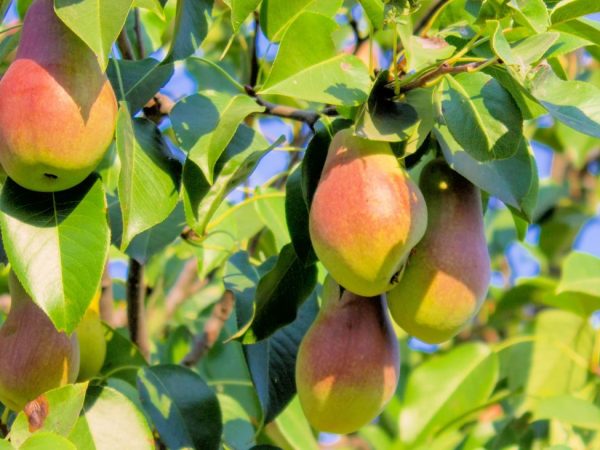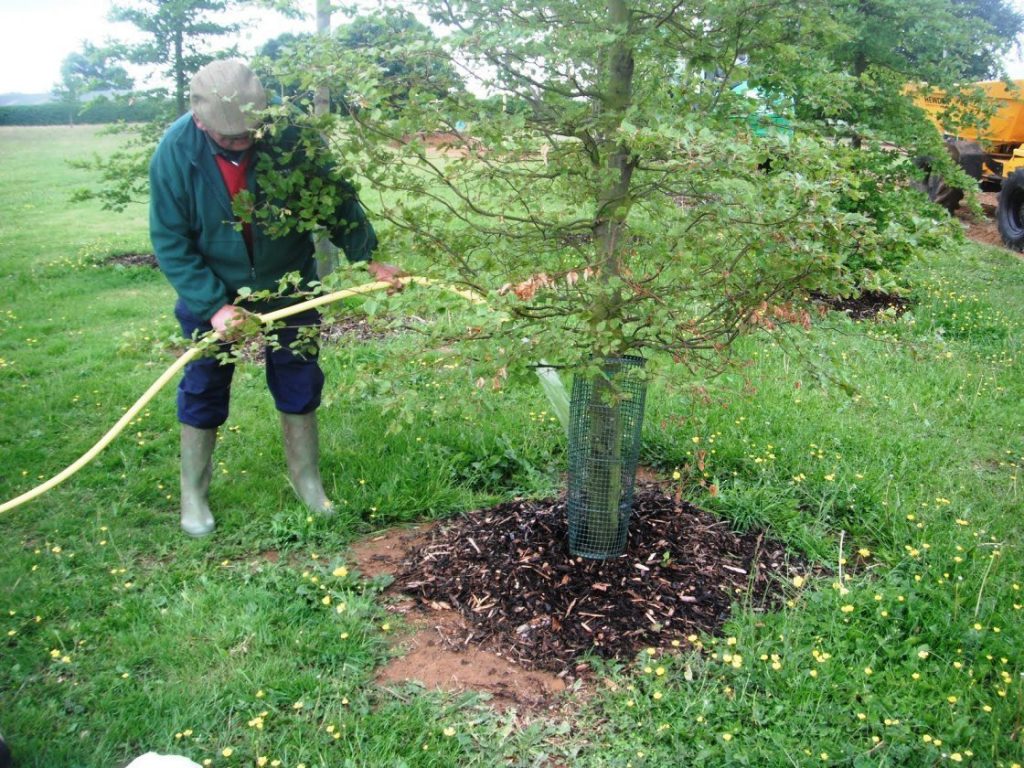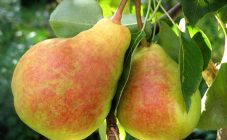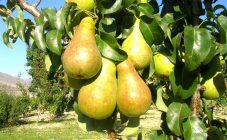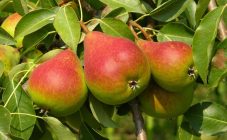Content:
Pear Perun is a variety of varieties of Altai selection. In 1998, the first trees were planted in the regions of Western and Eastern Siberia, where fruiting took place for the first time. Despite the harsh climate of Siberia, the tree has a high yield and is immune to adverse natural factors.
Characteristics and description of pear Perun
The pear variety Perun was first bred at the Siberian Institute of Horticulture named after I. M.A.Lisavenko. To obtain such a variety, breeders had to cross several varieties (Bergamontnaya, Vnuchka and Dekanka winter).
- The maximum tree height is 6-7 meters, which is an average figure;
- Trees have a spreading crown, not prone to thickening;
- Shoots are in the shape of an arc, differing in color from the main trunk;
- Leaves are medium in size, wide, ovate, with a concave, but even blade at the edges, dark green.
The first fruiting occurs no earlier than 4 years after planting, and a delay of up to 6 years is possible. Fruits begin to ripen in late autumn - at the end of October, the ripening period ends with the onset of frost.
Ripe fruits weigh from 140 to 200 g; under the influence of abiotic factors, they can crumble, but at the same time they do not acquire the desired taste.
- The shape is correct, pear-shaped, asymmetric fruits are often found;
- The surface of the fruit is tuberous;
- The skin is smooth, with a characteristic glossy sheen;
- There are green subcutaneous points;
- Ripe fruit has a greenish tint and a red blush on one side;
- Inside the fruit, in small, closed-type seed chambers, there are small narrow seeds;
- The peduncles are curved, short;
- The pulp is white, fine-grained with a pleasant aroma.
The taste of the Perun variety is not lost when stored in the refrigerator for up to several months.
Those who are seriously engaged in the cultivation of pears of the Perun variety try to remove all the fruits from the trees at least a week before they are fully ripe. This is due to the fact that the still unripe pear, after lying for several days after harvest, becomes more juicy.
The yield is moderate, regular. From one tree, you can get up to 18 kg of harvest.
The Perun variety does not tolerate low temperatures. In winter, insulation is required if the temperature drops to -25 ° C. Low temperatures also negatively affect the taste of the fruit, so you should start harvesting even before frost. The shelf life of frozen fruits is also reduced to 30-50 days, instead of 90-100.
Advantages and disadvantages of the variety
The Perun variety was bred specifically for cultivation in Siberia, but the most favorable areas for cultivation are southern.
The advantages of the variety:
- High yields with proper care;
- Large fruits;
- Resistant to frost down to -25 ° C;
- High immunity to various fungal diseases and scab.
Disadvantages of the variety:
- It is necessary to insulate trees for the winter;
- The variety does not have the ability to self-pollinate, therefore, next to the tree, it is necessary to plant from three to four pears, which bloom in the same period as Perun, but can self-pollinate.
Agrotechnics
When choosing a place for planting pears, it is better to opt for a well-lit area, but at the same time protected from the wind.
By avoiding open areas with strong gusts of wind or drafts, more crops can be saved. The soil should be loamy or mixed with sand, but black soil is considered the most suitable.
Planting a seedling in the ground is carried out in the spring in a pre-prepared hole (it is better to prepare it in the autumn period or at least 2-3 weeks before planting) with a depth of 115 cm, and with a diameter of 70-80 cm.The pit is additionally treated with a solution of lime (2 glasses are diluted in 10 liters of water). The soil that was extracted during digging must be mixed with humus, sand and any phosphate fertilizer.
In the spring, the pit is filled with a substrate half, the tree is placed on the resulting hill and the roots are straightened, after which they are covered with a mixture of soil with fertilizers.
The hole is well spilled with warm, settled water, about 20-25 liters will be required. To a height of 4-5 cm around the planted tree, it is necessary to form a near-stem circle, the radius of which will be 40-45 cm.The last stage - the top of the hole is covered with humus or peat fertilizer with a layer of 2-3 cm.
Watering
In the first few years of pear growth, watering should be done regularly. For an adult tree - from 25 to 40 liters of water, for a seedling - 10-15. In the case of heavy rainfall, the number of liters is halved. As it grows, constant artificial watering stops, it is carried out exclusively during the flowering period.
Top dressing
The first feeding of the tree is carried out two years after planting; fertilizers should be applied to the soil regularly. The best choice would be any organic fertilizer, for example, ash, manure, chicken droppings. During the flowering period, it is better to use potash fertilizers, and during the appearance of buds, phosphorus fertilizers.
Pruning
To increase the number of fruits and give the tree a more well-groomed look, it is necessary to properly and timely prune the crown, observing the rules:
- For the first time, the crown must be pruned after 2 years;
- Pruning is done with a secateurs;
- The central and main pillar is cut in half;
- The main reference point should be the ring inundation;
- 5-6 branches remain on the main part of the tree, which grow at an angle of 45-50 degrees in relation to the trunk;
- Once a year, all unnecessary branches are cut by at least 30%;
- Young branches that grow from the main trunk are not pruned.
- At the end of the work, the ends of the branches are treated with oil paint.
Pruning is a very important step in the care of the Perun pear, because in this way it is possible to ensure the penetration of sunlight to the entire crown.
Pest and disease resistance
Untimely or improper care of the Perun variety can greatly affect the susceptibility of the variety to various diseases and pests.
Some pests and methods of dealing with them are listed below.
| Pest | Specifications | Harm done | Methods of struggle and protection |
|---|---|---|---|
| Galitsa sheet | The size does not exceed 2-3 mm. The body has a brownish tint, the wings are transparent. By constitution, it resembles a mosquito, but is smaller. | Harmful to freshly cut trees. The edges of the leaf plate thicken and begin to resemble growths due to the complete absorption of the juice. | 1. Destruction of the pest nest; 2. Treatment of wood with insecticides. |
| Medianitsa | A small jumping insect, one of the first to appear in the middle of spring. | I produce a large amount of sticky substance, and completely suck out moisture from the sheet plate. | Before the pear blossoms, damaged ovaries are completely removed, and the tree is treated with special chemical compounds that destroy the pest. |
| Gall mite | Has microscopic dimensions. It lives inside the buds and on the leaves. | In the habitat of this insect (on the leaves and buds), galls are formed - swellings of a light shade, which turn black after a certain period of time. This is due to the fact that the tick feeds on tree sap. Leaves dry and fall off, not having time to survive the period of late spring. | Trees are sprayed with a solution of colloidal sulfur: - 200 grams of sulfur for 2 liters of water. |
The Perun variety gained popularity due to its good yield and its taste. It is important that the fruits can be consumed not only fresh, but also processed. The pear is subject to drying, heat treatment, it can be used in winemaking.
By following simple rules for caring for a pear tree, you can get a good harvest and enjoy the result in the form of jam and compote on cold winter evenings.
